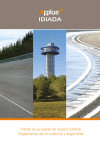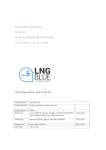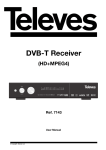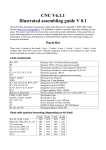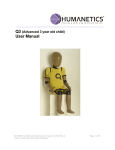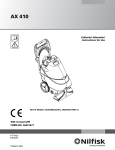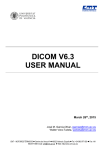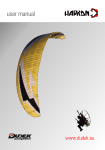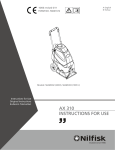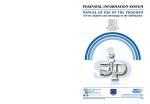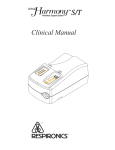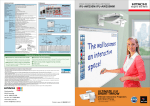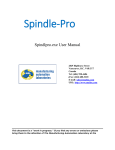Download Applus IDIADA Proving Ground Driving and Safety Regulations
Transcript
Applus IDIADA Proving Ground Driving and Safety Regulations INTRODUCTION INDEX GENERAL INFORMATION SPECIFIC RULES FOR DRIVING IN THE PROVING GROUND Timetables4 Proving Ground Controller 4 Safety Car 4 Test Driver 4 Test Vehicle 5 OVERVIEW OF PROVING GROUND20 TRACK 0 General Road 22 TRACK 1 High Speed Circuit 24 TRACK 2 Noise Track 34 TRACK 3 Fatigue Track A / Confidentiality conditions and photography 6 Comfort Track A 36 GENERAL RULES FOR USE OF THE TRACK 4 Dynamic Platform A 40 PROVING GROUND TRACK 5 Dry Handling Circuit / Access to the Proving Ground 7 General safety conditions and use of the Proving Ground 8 Maximum driving time 9 Seat belt and helmet 10 Special testing 10 14 User’s manual for the radio system 15 Automatic barrier system 16 TRACK 6 Test Hills 46 Comfort Track B & Sim City 48 TRACK 9 Dynamic Platform B 52 TRACK 10 Off Road / Forest Track 54 TRACK 11 Wet Circle 57 TRACK 12 Wet Handling Circuit 58 Welcome to the Applus+ IDIADA Proving Ground. This document features the safety and driving rules that all users of our Proving Ground need to know and observe. APPENDIXES Appendix A: Classification of non-com- Refuelling16 pliances of the driving regulations Non-compliance of the Proving Ground Driving and Safety Regulations 42 TRACK 7 Straight Line Braking Surfaces / Exceptional tests 10 Variable message signs Dynamic Platform C The purpose of these rules is to ensure maximum safety for all users. controlling access to the Proving Ground 64 Appendix C: User’s manual for refuelling 66 WHAT TO DO IN THE EVENT OF AN ACCIDENT ON THE PROVING GROUND ADDITIONAL INFORMATION How to detect that you are in an accident situation within the Proving Ground Please do not hesitate to contact our client services team if you have any queries or would like further information about these regulations. 60 Appendix B: User’s manual for the system for 17 Thank you in advance for your cooperation and help in making IDIADA into one of the safest Proving Ground facilities in Europe. 18 Contact numbers 68 Given that non-compliance with these regulations may endanger not only the offender but also other users. IDIADA reserves the right to restrict access to any users who fails to respect the Driving and Safety regulations. What to do in the event of an accident 18 2 3 GENERAL INFORMATION GENERAL INFORMATION TIMETABLES SAFETY CAR • The Proving Ground, medical services, Safety Car and Proving Ground Controller services are operational 24 hours a day, 7 days a week. • The Proving Ground will be closed to traffic from 22:00 on 24 December until 06:00 on 26 December, and from 22:00 on 31 December until 06:00 on 2 January. PROVING GROUND CONTROLLER • This is an IDIADA vehicle which is marked as “Safety Car” and is operated by IDIADA personnel. • The Controller is responsible for managing and controlling traffic within the Proving Ground and ensuring compliance with the Proving Ground Driving and Safety Regulations. • The Controller is responsible for coordinating internal and external emergency teams in any emergency situation that may take place within the Proving Ground. The Controller is the maximum authority of all traffic management within the Proving Ground: his or her instructions must be followed at all times. TEST VEHICLE • Test vehicle means any vehicle which is used for carrying out tests on the Proving Ground. • The client must have a valid insurance policy which covers the risks of accident, personal injury and material damage to third parties and any damage that may be caused to IDIADA facilities. • All drivers must have a corresponding driving licence for the type of vehicle which is to be tested on the Proving Ground. Drivers are responsible for this and must inform IDIADA if they do not have a valid driving licence. Vehicles using the following fuels must be identified with the corresponding stickers: • Its main function is to ensure that all Proving Ground users observe the Proving Ground Driving and Safety Regulations by constant supervision of the tracks. Instructions from the Safety Car must be followed at all times. • The Proving Ground Controller is based in the Control Tower and is the principle contact for Proving Ground users • If the client has their own procedures in place for assessing their test drivers, they may make a written application for IDIADA to control and refuse entry to the Proving Ground to anyone from their company who is unable to give documentary proof of complying with such requirements. TEST DRIVER HYDROGEN • The driver is responsible that the vehicle has been checked before entering the Proving Ground facility and for ensuring that it is fitted with all the safety measures laid down for testing, as well as all the signalling features set out in these regulations. GAS GLP GAS CNG • Test driver means anyone who is qualified to drive in the IDIADA Proving Ground facility. HYBRID • The client is responsible both for the professional ability and qualifications of the engineers, drivers, operators etc. which they send to carry out tests at IDIADA, and also for ensuring that these workers are suitably insured. However, IDIADA shall be responsible for these requirements when it provides the workers. ELECTRIC CNG, GLP, Hybrid, Electric and Hydrogen stickers are available in the Control Tower reception. • Any damage caused by the client to IDIADA’s installations will be invoiced accordingly. 4 5 GENERAL RULES GENERAL RULES FOR USE OF THE PROVING GROUND CONFIDENTIALITY CONDITIONS AND TAKING PHOTOGRAPHS • The transponder enables the Tower Controller to automatically identify the vehicle and the test it is performing. Changing the transponder of the vehicle once in the Proving Ground or doing another type of test other than the ones specified when the track reservation was made is absolutely forbidden. ACCESS TO THE PROVING GROUND • Users must register at the Control Tower reception every day before beginning their testing programmes. • Supervision of the authorised photography: • No type of image recording device – including mobile phones with cameras – may be brought into the IDIADA complex. - Camera NOT FIXED to the vehicle: in this case the client shall be accompanied by an IDIADA staff member at all times. • Everyone who comes into the IDIADA complex must observe the confidentiality. All of other clients and the tests being carried out at IDIADA. - Camera FIXED to the vehicle: in the event that the camera forms part of the instrumentation fixed to the vehicle, its installation must be supervised by an IDIADA member of staff appointed by the Proving Ground Safety Supervisor. The vehicle must be identified with a sticker informing that the vehicle has a fixed camera on board. This sticker will be given to the client together with the necessary authorisation. • In the event that a test requires the use of any audio-visual recording equipment, a written application for authorisation must be made in adnvance to the Proving Ground Safety Supervisor. • At reception the user must present their Proving Ground Driving Permit as accreditation for entering the Proving Ground; this accreditation makes it possible to verify that the user is aware of the prevailing Proving Ground Driving and Safety Regulations. • Users must return the radios every day once testing has been completed so that the batteries can be recharged. • Each vehicle must have at least one reflective safety vest or jacket on board. They are available at the Control Tower reception desk. • Users may only enter and exit the Proving Ground Facility through the gate at the Control Tower, except in the case of Dynamic Platform B which is accessed from the area in front of the M workshops. • If the vehicle is fitted with a fire extinguisher, the extinguisher must always be firmly attached. • In order to enter the Proving Ground Facilities, users must have a portable radio and an electronic vehicle identification device (transponder) which they will be given when they register at reception in the Control Tower. Only one radio per permit will be provided. • When users enter the Proving Ground area; they must report the following information to the Proving Ground Controller by radio: 1 The identification number of their portable radio 2 The number of persons in the vehicle - Vehicles with fixed recording devices may drive on the Proving Ground as long as the client guarantees that no images are to be recorded. In all other cases the recording shall be carried out in an agreed and controlled manner. 6 3 Which test track they plan to use first 7 • IDIADA carries out random blood alcohol level controls on all drivers in the Proving Ground. If a driver should FAIL such a test, their immediate superior will be informed and the driver concerned will not be permited to enter the Proving Ground. • Users are NOT required to inform the Controller every time they enter or leave one of the Proving Ground Tracks. Equally they do not have to report on leaving the Proving Ground. • In order to plan testing and to ensure safety on the tracks, users must inform the Proving Ground Safety Supervisor or appointed delegate if the test that they are going to carry out can be considered to be special (See page 10). Before starting these tests users must ask the Controller for authorisation. Under no circumstances may drivers drive in the opposite direction to the one established for each track. Emergency vehicles will be permited to drive in the opposite direction to the established one only in case of emergency and only with the Controller’s prior authorisation. • Tyre pressures should be checked to make sure that they comply with manufacturers’ specifications, especially in the case of tests carried out at high speeds due to the increased load brought about by driving on the banks on the High Speed Circuit. • Equipment and other items installed on the outside of the vehicle must be checked to make sure that they are firmly secured and do not fall off in the Proving Ground. • Users should not handle computers, phones or other devices while driving. • In the case of motorcycle testing special measures will be taken to ensure the safety of riders. Users should inquire about these special measures beforehand with the Proving Ground Safety Supervisor. • Drivers may not get out of their vehicles except in designated parking areas and on the dynamic platforms. • Test instrumentation and any ballast used must be thoroughly anchored to prevent it from shifting. • Permission to get out of the vehicle on the dynamic platforms must be requested from the Platform Controller or the Proving Ground Controller. • Users must immediately report any accident, incident or damage occurring to the complex (tracks or facilities) by radio to the Proving Ground Controller. The Proving Ground Controller must also be informed of any spillage of oil, fuel or other liquids. GENERAL CONDITIONS OF SAFETY AND USE OF THE PROVING GROUND • Traffic signs and signals in the Proving Ground must be observed at all times. Instructions given by the Proving Ground Controller and by the Safety Car in the Proving Ground must be obeyed at all times. • Dipped headlights should be used when driving around the Proving Ground. In the event that the test being performed does not allow headlights to be switched on, the Proving Ground Safety Supervisor must be informed and permission requested prior to carrying out the testing. • Users must not drive while under the influence of medicines, alcohol or psychotropic substances which may induce drowsiness or a reduction in physical faculties. • Reflective vests or jackets must be worn outside the vehicle. They are available from Reception at the Control Tower. • In the event of breakdown, the vehicle must be stop in a parking area. If this is not possible, the vehicle should be parked on the edge of the road with its hazard warning lights on and the Controller should be informed by radio so that the vehicle can be removed from the Proving Ground as quickly as possible. Cars should never be abandoned in the Proving Ground. MAXIMUM DRIVING TIME • A maximum driving time of eight hours daily is recommended. Each driving shift must include rest breaks and not exceed two hours of continuous driving. In the case that the testing requires continuous driving time, without rest breaks, it is necessary to contact with the Proving Ground Safety Supervisor first. • Vehicles may not be left parked in the Proving Ground, unattended by its driver and without the express authorisation of the Proving Ground Controller. • Users must not drive if suffering from an illness or injury which restricts their capacity to perform the tests. • The test vehicle must be inspected prior to entering the Proving Ground with special attention being paid to brakes, tyres and lights. • In the event of doubts or queries, please contact Applus IDIADA’s medical service in the Control Tower (Ext.: 9381) 8 Driving in reverse is not permited unless previously agreed upon with the Proving Ground Safety Supervisor. • Rest breaks should be increased if the testing entails physical fatigue for the driver (testing at high speeds, fatigue track, rapid deceleration, adverse weather conditions, etc.). 9 SEAT BELT AND HELMET • All occupants of the vehicle must wear their seat belts. • Helmets must be worn in the event that safety bars are installed in the vehicle. SPECIAL TESTING Tests that can be classified as “Special” include: 1. Lane change and slalom tests 2. Speed reduction tests 3. Brake tests 4. Repetitive braking tests / Fading test 5. Very high speed tests • In dry conditions a safety distance of 400 metres must be maintained with respect to other vehicles. 2. SPEED REDUCTION TESTS: • In wet conditions a safety distance of 500 metres must be maintained with respect to other vehicles. • A Speed reduction test is a maneuver that requires applying the brakes with a deceleration of < 0.5 g IDIADA reserves the right to hire an external ambulance unit and fire response vehicle when certain special tests are to be carried out. The services will be invoiced to the client. 1. LANE CHANGE AND SLALOM TESTS: EXCEPTIONAL TESTS • IDIADA reserves the right to authorise tests that maybe in conflict with the Proving Ground Driving and Safety Regulations provided that this is required by the test and appropriate safety measures have been taken. Users of the Proving Ground will always be informed in the event of special testing. • Tests with non-habitual drivers (presentations to managers, dealers, invited Clients, etc.) must be authorised by the Proving Ground Manager. Such tests shall be restricted to specific times and shall require the presence of an additional external ambulance unit and fire response vehicle (charged to the client). Other users will always be told about them in advance and they shall always be performed under the supervision of IDIADA personnel. • Before starting, permission must be requested from the Proving Ground Controller. Only he or she may authorise the start of this type of testing. • The test vehicle must bear a numbered “Speed Reductions” GREEN PLATE at its rear. These plates are available at Control Tower reception. • The Proving Ground Controller must be informed when the testing is completed. • Lane-changing tests are not permited on the bends. • Check timetables for lane changing on the High Speed Circuit (see page 28). 001 • The test vehicle must bear a ROTATING GREEN LIGHT in an area which is visible to all other track users. This light must be on at all times. This light is available at Control Tower reception. • The test vehicle must bear a numbered “Lane Changes” WHITE PLATE at its rear. These plates are available at Control Tower reception. • The test vehicle must have a ROTATING WHITE LIGHT in an area which is visible to all other track users. This light must be on at all times. This equipment is available at the Control Tower reception. SR GREEN • The start of the manoeuvre must be indicated with the vehicle’s hazard warning lights, which must be switched on when lane changes begin and should be switched off when the manoeuvre is completed. • A safety distance of 200 metres must be maintained with respect to other vehicles. WHITE • The start of the manoeuvre must be indicated with the vehicle’s hazard warning lights, which must be switched on when lane changes begin and should be switched off when the manoeuvre is completed. 10 Check timetables for carrying out speed reduction tests on the High Speed Circuit (see page 29). 11 4. REPETITIVE BRAKING TESTS / FADING TEST: 3. BRAKING TESTS: • A Brake test is defined as decelerations ≥ 0.5 g • In dry conditions a safety distance of 400 metres must be maintained with respect to other vehicles. • The test vehicle must have a numbered “Brake Test” RED PLATE positioned on the back. These plates are available at the Control Tower reception . desk. • Before starting, permission must be requested from the Proving Ground Controller. Only he or she may authorise the start of this type of testing. • The test vehicle must have a numbered “Brake Test” RED PLATE positioned on the back. These plates are available at the Control Tower reception desk. • Permission must be requested from the Safety Car before starting. Only the Safety Car can authorise the start of this type of test. • In wet conditions a safety distance of 500 metres must be maintained with respect to other vehicles. • The Proving Ground Controller must be informed when the testing is completed. RED • Check timetables for carrying out braking tests on the High Speed Circuit (see page 30). • Very high speed tests are tests which require driving at speeds that excedes 250 km/h. • Tests at speeds that exceed 250 km/h: Full beam headlights must be on when driving during daylight. • The test vehicle must have a ROTATING RED LIGHT in an area which is visible to all other track users. This light must be on at all times. These lights are available at the Control Tower reception . • Brake tests are not permited on the bends. • The test vehicle must have a ROTATING RED LIGHT in an area which is visible to all other track users. This light must be on at all times. These lights are available at the Control tower reception desk. 5. VERY HIGH SPEED TESTS: • The start of the manoeuvre must be indicated with the vehicle’s hazard warning lights, which must be switched on when starting the repetitive braking test or fading test and should be switched off when the manoeuvre is completed. • In dry conditions a safety distance of 400 metres must be maintained with respect to other vehicles. • Permission must be requested from the Safety Car before starting. Only the Safety Car can authorise the start of this type of tests. • The Safety Car must be informed when the tests finishes. • Check timetables for carrying out very high speed tests on the High Speed Circuit (see page 31). RED • The start of the manoeuvre must be indicated with the vehicle’s hazard warning lights, which must be switched on when braking at high speed begins and should be switched off when the manoeuvre is completed. NOTE: Other rotating lights that are permitted on the Proving Ground: • In wet conditions a safety distance of 500 metres must be maintained with respect to other vehicles. • The Safety Car must be informed when the tests is completed. ORANGE Maintenance vehicles • Check timetables for carrying out repetitive braking tests/Fading Test on the High Speed Circuit (see page 30). 12 13 BLUE Emergency vehicles VARIABLE MESSAGE SIGNS USER’S MANUAL FOR THE RADIO SYSTEM 2. QUEUED CALLS There are variable message signs on the High Speed Circuit and the General Road. Safety messages which require that testing must stop immediately: If all channels are engaged, the following letters will be displayed: Examples of other messages: “COL” “ESP”, “OCU” or “RED’’. This means that the call is being queued and you have to wait. Button 3. COMMUNICATION WITH THE CONTROLLER Button Start your conversation with the Controller by stating the NUMBER to be found on the front of your radio and end by saying “OVER”. OBJECTS ON THE TRACK Example: Vol. “310 requests permission to enter the General Road. OVER.” ANIMALS ON THE TRACK 1. MAKING A CALL 4. BARRIER NUMBERS Normal call to the Controller: The access barriers are marked with a number to make them easier to locate. 1. Press the button to open a channel with the Controller. The unit emits a sharp beep. Stop vehicles immediately Instructions given by controllers using the variable message signs must be followed. Designation is as follows: 0 General Road 2. When you hear a double beep and appears press and speak. on the display, 1 High Speed Circuit 2 External Noise Test Track 3 Fatigue Track A / Comfort Track A 4 Dynamic Platform A Emergency call: 5 Dry Handling Circuit / Dynamic Platform C 1. Press + to open channel. 6 Test Hills 7 Straight Line Braking Surfaces / 2. When you hear a double beep and appears on the display, press and speak. Comfort Track B & Sim City 9 Dynamic Platform B 10 Pista Off Road Only use in the event of an accident! 14 11 Wet Circle 12 Wet Handling Circuit 15 AUTOMATIC BARRIER SYSTEM • When users register at Control Tower reception they will be given a transponder which automatically opens the barriers when detected by the antenna at the entrance to each of the authorised Test Tracks. Each transponder has its own identification code. The procedure for installing and using the transponder is explained in Appendix B: Users’ Manual for the System of Controlling Access to the Proving Ground. • Only one vehicle may enter each time the barrier is raised. In the event of a malfunction with the barrier, the user should contact the controller by radio stating the transponder’s identification code. REFUELLING • Vehicles may only be refuelled at the petrol station and the adjacent secure fuel storage facility. In order to refuel users will need a fuel card which they can collect from Control Tower reception. See appendix C: User’s Manual for Refuelling. • If due to the nature of the test it is necessary to refuel in an area other than in the petrol station, the Proving Ground Safety Supervisor must be notified in advance. NON-COMPLIANCE OF THE PROVING GROUND DRIVING AND SAFETY REGULATIONS VERY SERIOUS NON-COMPLIANCE: • The Proving Ground Controllers and the Safety Car are assigned the task of detecting non-compliance of the Proving Ground Driving and Safety Regulations. VERY SERIOUS Is the immediate temporary withdrawal of the permit for accessing the Proving Ground. • Any breach of the Proving Ground Driving and Safety Regulations that is detected by a user must be reported to the Controller. This makes it possible to take immediate action and helps prevent accidents. Permits will be removed from any user who: - Is in very serious non-compliance of the Proving Ground Driving and Safety Regulations. • There are three categories of non-compliance of the regulations: - Repeats a serious non-compliance of the Proving Ground Driving and Safety Regulations during the 30-day period laid down for the serious non-compliance. SIGNIFICANT NON-COMPLIANCE: - Accumulates four (4) serious non-compliances in the space of one year. SIGNIFICANT • Every time a significant non-compliance of the regulations is found to have taken place; a verbal warning will be given to the offender in which they are asked to change their behaviour. • In the event of accident, all the barriers in the Proving Ground will open to facilitate the arrival of emergency services. • The minimum period for which Permits giving access to the Proving Ground may be withdrawn will be one (1) week. • In the event that the offender pays no attention to the instructions they receive or continues to commit minor non-compliances of the regulations, the offence will be upgraded to a serious non-compliance. • Each case shall be assessed independently and the exclusion periods will be set jointly by the Manager of the Proving Ground Department together with the Proving Ground Safety Supervisor. SERIOUS NON-COMPLIANCE: • This warning shall be registered and the offender will not be permited onto the Proving Ground. SERIOUS • A list giving examples of significant, serious and very serious non-compliances can be found in Appendix A: • Every time a serious non-compliance of the regulations is found to have taken place, a written warning will be given. This warning shall be in force for thirty (30) days, during which any new serious non-compliances shall entail the automatic temporary withdrawal of the permit for accessing the Proving Ground due to an accumulation of non-compliances of the regulations. 16 Classification of non-compliances of the Driving Regulations. 17 WHAT TO DO IN THE EVENT OF AN ACCIDENT ON THE PROVING GROUND Radio: • Accident message from the controller WHAT TO DO IN THE EVENT OF AN ACCIDENT: • Accident means an unintended event which results in own or third-party personal injury or property damage. • This service consists of: • The radio channel must be left clear and users should wait for instructions from the Proving Ground Controller. • Injured people should not be moved even when they have no visible injuries (they may have internal injuries). Injured people should not be permited to move, but rather kept calm while waiting for the emergency services to arrive. - Ambulance unit with nurse - Rapid response vehicle with firefighting capability - Safety Car • If the user wants additional emergency measures, they must ask the Proving Ground Safety Supervisor for them in advance. Visual: • Accident message on the variable message signs All accidents must be immediately reported by radio to the Controller. • In the event of an imminent risk of fire, injured people should be removed with extreme care avoiding sudden movements. • When the emergency protocol is activated, Applus IDIADA always call for an external ambulance. This service may only be cancelled by Applus IDIADA medical personnel after examining the injured. • Users are asked to keep calm and wait for instructions from Controller. The report must be brief, clear and state: • Gates open on all test tracks within PG - The exact location on the Proving Ground - Seriousness of the accident - The number of people injured • When the accident report is received the emergency protocol is activated by the Proving Ground Controller. • The Proving Ground Controller will coordinate all emergency services. • BLUE rotating lights on Located at the entrance to some of the tracks and also at strategic locations on the General Road. • All accidents within the Proving Ground are viewed as being serious and are treated in exactly the same way. • The Proving Ground Controller shall notify all Proving Ground users of the accident by radio in English and in Spanish. Message in the event of accident: “Control Tower to all track users. There has been an accident on the tracks please stop all testing immediately.” • All testing within the Proving Ground must stop immidiately. • All vehicles must stop in the nearest parking area or on the edge of the road so that they do not interfere with emergency vehicles. • RED flashing signs on Located on the High Speed Circuit. 18 19 ACCIDENT ON THE PROVING GROUND HOW TO DETECT THAT THE ACCIDENT PROTOCOL HAS BEEN ACTIVATED: • In the event of an accident Applus IDIADA’s own emergency service will attend to any Proving Ground users who have been injured while awaiting external assistance. SPECIFIC RULES FOR DRIVING ON THE PROVING GROUND TRACKS General overview of IDIADA’s Proving Ground and individual track numbering: 0 General Road 6 Test Hills 1 High Speed Circuit 7 Straight Line Braking Surfaces 2 External Noise Test Track 7b Comfort Track B & Sim City 3 Fatigue Track A / Comfort Track A 9 Dynamic Platform B 4 Dynamic Platform A 10 Off Road Track 5 Dry Handling Circuit 11 Wet Circle 5b Dynamic Platform C 12 Wet Handling Circuit 20 21 TRACK 0 GENERAL ROAD 150 100 Brak ing a rea Entrance General road Flat section with longitudinal gradient 0% North Straight South straight wide area 0 N E W 80 S Petrol station Parking area with lift Parking South Straight / Lane changes area 100 Approach zone South straight wide area Direction of travel Clockwise Total length 5.333 m Length of south straight 1.620 m Longitudinal gradient (south straight and braking area) 0% South straight wide area (length) 300 m South straight wide area (width) 20 m Braking area (length) 250 m Braking area (width) 10 m Braking area (approach lane) 100 m • Maximum permitted speed on the north and south straights of 150 the General Road * • Minimum permitted speed on the rest of the General Road * • Maximum permitted speed on the rest of the General Road * 100 • Maximum permitted speed on the 80 east straight * Braking zone 150 GENERAL RULES BRAKING AREA ON THE NORTH STRAIGHT • The General Road is the principle access road to all the other Test Tracks. Care should be taken with other vehicles when entering and leaving it. - Only 1 car is permited in the braking area 1 • Users should always drive in the right lane except when overtaking. • When driving at slow speeds (< 30 km/h), emergency lights must be on. • Lane change tests are only permitted in the South straight. • Brake tests are only permitted in the braking area. * The user has to adjust the maximum speed of their vehicle to track conditions. 22 23 TRACK 1 HIGH SPEED CIRCUIT (HSC) North straight Entrance Straights Bends N S Parking E W Braking Areas bend East bend Wifi zone South straight Direction of travel Clockwise Neutral steer speed (bends) 200 km/h Length Lane 1 7.493 m Maximum banking (bends) 80% (38.66º) Length Lane 2 7.513 m Radius of the bends 471 m Length Lane 3 7.546 m Longitudinal gradient (North straight) - 0.3 % Length Lane 4 7.579 m Longitudinal gradient (South straight) + 0.3 % Length of straights 2.000 m Transverse gradient (straights) 1,0 % 24 25 1 West SPECIAL TESTING GENERAL REGULATIONS Tests that can be classified as “Special” include: 1. Lane change and slalom tests 2. Speed reduction tests 3. Brake tests 4. Repetitive braking tests / Fading test 5. Very high speed tests 07:30h 18:00h 19:00h 13:00h 14:00h 07:30h 08:30h Speed limits 400 m signage on the shoulder: Restricted Timetable LANE LANE LANE LANE 4 3 2 1 MAXIMUM SPEED 250 200 150 100 MINIMUM SPEED 160 130 80 50 Afternoon/Night Timetable LANE LANE LANE LANE 4 3 2 1 MAXIMUM SPEED 250 200 160 RESERVED Central Timetable MINIMUM SPEED 160 130 15 0 Variable depending on the type of test 200 metre strips have been painted (alternately in orange and white) on the boundary lines of the shoulder on both sides of the two straights to provide visual confirmation of the 400 m safety distance between vehicles. 200m 200m Lane 1 is reserved for braking and deceleration tests. • Speed limits by lane are applied to all tests, except for lane changes or slaloms, which have specific regulations (see page 28). OVERTAKING: You must consult with the Proving Ground Safety Supervisor about the minimum safe distance between vehicles when performing special tests that are not defined in these Safety Regulations. Consult • All overtaking must be done on the left. Users may only change lanes when it is safe to do so and the manoeuvre must be indicated in advance. • Tests at speeds exceding 210 km/h: Full beam headlights must be on when driving during daylight. • Vehicles using lane number 4 (left) must always give way to faster vehicles by moving to lane number 3. • Before entering the bends users must look in their rear-view mirrors to check which vehicles are on the track and thus anticipate possible overtaking by faster vehicles. • Lanes may only be changed in the bends when this is made necessary by the presence of other vehicles. • Tests at speeds exceeding 250 km/h must be carried out under exclusive use conditions. 26 27 TIMETABLE REGULATING SPECIAL TESTS ON THE HIGH SPEED CIRCUIT: Central Timetable Central Timetable Restricted Timetable Restricted Timetable 07:30h 18:00h 19:00h 13:00h 14:00h 07:30h 08:30h 07:30h 2. Speed reduction/deceleration tests (deceleration < 0.5 g) 18:00h 19:00h 13:00h 14:00h 07:30h 08:30h 1. Lane change and slalom tests Afternoon/Night Timetable Afternoon/Night Timetable MINIMUM SPEED 50 MINIMUM SPEED 0 NOT PERMITED MAXIMUM SPEED MINIMUM SPEED (*) 220 Speed tests: > 220 km/h Check with the Proving Ground Safety Supervisor 48 hours in advance Only in Braking areas (see page 32) NOT PERMITED * Lane change and slalom tests at speeds less than 100 km/h are not PERMITED on the High Speed Circuit and must be carried out on other tracks. 28 29 Check with the Proving Ground Safety Supervisor 24 hours in advance 07:30h 160 MINIMUM SPEED 0 Note: When Brake Tests, Repetitive Braking Tests or Fading Tests are conducted, lanes 1 and 3 will be used to perform the tests and lanes 2 and 4 may only be used for overtaking. Only in Braking areas (see page 32) Central Timetable Restricted Timetable 5. Very high speed tests 07:30h 18:00h 19:00h 13:00h 14:00h 07:30h 08:30h 4. Repetitive braking tests / Fading tests Afternoon/Night Timetable Central Timetable Restricted Timetable 07:30h NOT PERMITED MAXIMUM SPEED 18:00h 19:00h Tests with initial speed: > 160 km/h Afternoon/Night Timetable 13:00h 14:00h Restricted Timetable Only overtaking Braking tests Only overtaking Braking tests Lane 4 Lane 3 Lane 2 Lane1 07:30h 08:30h Central Timetable 18:00h 19:00h 13:00h 14:00h 07:30h 08:30h 3. Brake tests (deceleration ≥ 0.5 g) Afternoon/Night Timetable Tests with speed: NOT PERMITED Check with the Proving Ground Safety Supervisor 24 hours in advance 30 NOT PERMITED NOT PERMITED > 250 km/h Check with the Proving Ground Safety Supervisor 48 hours in advance 31 NOT PERMITED BRAKE TEST PROCEDURE BRAKING AREAS: • Timetable from 19:00 to 07:30 • On the High Speed Circuit there are 4 dedicated Braking Areas: 3 4 Lane 4 Lane 3 Lane 2 Lane 1 1 200 m SAFETY ZONE 2 LANE 1 1 2 500 m APPROACH ZONE BRAKING ZONE 200 m 500 m 300 m 300 m APPROACH ZONE 1 SAFETY ZONE 4 3 BRAKING ZONE 2 1 1 2 2 3 3 4 4 3 4 • To perform the test, the area is regulated by a traffic light: Green traffic light: Area not in use. The test can be carried out Red traffic light: Area being used by another user. The test cannot be carried out. 1 1 2 2 3 3 4 4 • If red, the user must continue driving until it is not in use (green traffic light). • Only 1 car is permited in each Braking Area 32 1 33 TRACK 2 NOISE TRACK Test area dimensions 22 x 20 m Length of acceleration lane 300 m • Slalom testing and brake testing are not permited. • Only one user may perform tests on this track at any one time. 2 Entrance N E W S Acceleration lane ISO I surface ISO 10844:2011 ISO II surface ISO 10844:1994 34 35 TRACK 3 FATIGUE TRACK A / COMFORT SURFACE A FATIGUE A from 06:30h to 18:30h Anti-clockwise from 18:30h to 06:30h Undulating concrete 145 m Potholes with water 220 m Gravel area 455 m Undulating concrete with stones 420 m Water wade (depth adjustable) 50 m x 4 m x ( 0 - 50 cm ) Salt water wade (depth adjustable) 20 m x 4 m x ( 0 - 50 cm ) Forest track 1950 m Block pavé I 827 m Block pavé II 922 m Repaired asphalt 149 m Stop & Go area 300 m Curbs 250 mm FATIGUE A 200 mm 150 mm Entrance 100 mm COMFORT A Clockwise Direction of travel • The access to the salt water wade and mud water wade facilities should be authorized by the Proving Ground Client Services before use. A minimum notification of two days is required. from 06:30h to 18:30h Forest track Salt water wade Belgian block pave (I) Twist road Belgian block pave (II) Misuse test area Cobblestone road Curbs Repaired asphalt Inputs Curved rough road Comfort road Pavé surface (length) 599 m Splash road Mud water wade Road in poor condition (length) 1311 m Water wade Trailer ramp simulation Anti-clockwise • The configuration will be changed twice a day. Before entering the track, look at the traffic signals to check the current configuration. Direction obligatory from 18:30h to 06:30h • The maximum speed on all of the track surfaces is 80 km/h*. Tests exeeding this speed require prior authorisation from the Tower Controller, who will also advise all other users. * Users should adjust the maximum speed of the vehicle according to the current conditions of the circuit. Prohibited 36 3 Clockwise Direction of travel • The water wade is set at 15 cm by default and can be adjusted from 0 to 50 cm. If a specific water height is required the Control Tower must be informed at least two days in advance. N E W S COMFORT A Smooth perfile Badly mantained road Symmetrical profile Bottoming Assymetrical 90º profile Washboard 1 Assymetrical 180º profile Washboard 2 37 N E W S HILL 15% Section A Section B 15% VARIABLE HILL 3% Section C PEDESTRIAN HILL WAVY ROAD 3% TRAILER RAMP SIMULATION Section A 15% PEDESTRIAN HILL Variable Hill 3% 4.00m 15% 15% 15% Section C VARIABLE HILL 3% HILL 3% PEDESTRIAN HILL 0.67 WAVY ROAD HILL 15% Section A Section A Section A: 15% 0.25m Section A 7.08m 15% VARIABLE HILL PEDESTRIAN HILL 15% 3% 3% 1.05m WAVY ROAD 15% 15% PEDESTRIAN HILL WAVY ROAD 7.00m 3% 3% 3% and 15% hills 1.70m VARIABLE HILL PEDESTRIAN HILL VARIABLE HILL 7,10m 15% 2,21m WAVY ROAD WAVY ROAD HILL 3% 7,00m 15º HILL 15% HILL 15% HILL 15% 0,46m HILL 15% m 1,95 HILL 3% 7,00m 15% Section C Section C PEDESTRIAN HILL 0,67m 6º 1,90m 3% 3%7,00m 15% 15% 4.40m HILL 3% HILL 3% Section B Section C Section C 1.90 Section B 15% 3% 3% 3% 15% 15% HILL 15% 1.40 1.30 2.20 Section C VARIABLE HILL VARIABLE HILL 5.00m WAVY ROAD Section B 15% 3% 3% PEDESTRIAN HILL Section A Section B 1.70m 3% HILL 3% HILL 15% 8.40m 3.00m 10.00m Section B Section B Pedestrian Hill WAVY ROAD 17.00m Section A Section A Section C VARIABLE HILL 3% 3% HILL 3% Section B Section B: 2,20m 0m 2.2 0,67m 1.40m Removable metal plates 6,8º 15º Section C: 4.20m 10.00m 0.4 0.8 0.4 1.20m Wavy Road 38 39 TRACK 4 DYNAMIC PLATFORM A (DP-A) CROSSWIND TESTS 250 m length x 250 m width Platform dimensions 850 m Acceleration lanes on both sides of the platform Radius of circles R (m) • Users wishing to use the crosswind facility should first contact the Client Services team to schedule the time for their tests. 5,2 12 12,5 15 20 30 35 40 50 60 80 100 110 120 R24 m Bernouilli Lemniscata 0% Transversal and longitudinal gradient of the platform Technical specifications: - Number of fans: 10 units (2.6 m high x 2.6 m wide) - Length: 30.5 m - Acceleration lane: 600 m - Maximum wind speed: 25 m/sec TRACK TIMETABLE: USE REGULATED BY DP-A CONTROLLER (1) SHARED USE (2) 00:00 09:00 SHARED USE TIMETABLE: Priority timetables have been established based on test type. (2) 17:00 24:00 Priority will be given to the tests specified in each time slot: (2) Shared DP-A use timetable. During this time there is no Controller and users must arrange carrying out tests with the other users. If it is not possible to come to an agreement, contact the Proving Ground Controller. • From 08:00 to 09:00 – Cross Wind / ISO 3 • From 09:00 to 11:00 – VDA, Slalom, G-turns, Gymkhana Parking / Meeting Point • From 11:00 to 12:30 – Circles / ISO 3 4 (1) DP-A Controller operating timeframe. Monday to Friday from 09:00 to 17:00. Before starting the test, users should go to the parking area (meeting point) to coordinate their tests with the DP-A Controller. • From 12:30 to 13:30 – Cross Wind / ISO 3 Each user will be provided with a separate radio to recieve instructions throughout the test. • From 13:30 to 15:30 – VDA, Slalom, G-turns, • From 15:30 to 18:00 – Circles / ISO 3 N • When walking around the platform reflective clothing must be worn; this clothing can be obtained from Control Tower reception. • From 18:00 to 19:00 – Cross Wind / ISO 3 W There is a neon sign at the entrance to the track which indicates whether the circuit is operating at full capacity. S E Gymkhana • From 19:00 to 08:00 – Free use not permited. FULL : WAIT Access GO AHEAD Free access. • Helmets must be worn if the vehicle is fitted with internal safety bars. Dynamic platform Slalom area • Any damage caused to the track surface must be reported to the Proving Ground Controller • Use of anti-roll supports with wheels is not permited. Only the ones whose ends are hemispheres made of polyethylene or another sliding material are permitted. Acceleration lanes ISO III surface Parking / Meeting Point / Traffic light Cross wind Wifi zone Entrance / Exit 40 41 TRACK 5 DRY HANDLING CIRCUIT / DYNAMIC PLATFORM C (DP-C) N E W S Overtaking area Overtaking area 5 Entrance DYNAMIC PLATFORM C MAIN Circuit DYNAMIC PLATFORM C. WHITE layout. YELLOW Layout. Open all the time Parking area with lift. General configuration, therefore users have the right of way when driving. Overtaking area (MAIN Circuit) ALTERNATIVE Circuit ORANGE layout. This map is located at the entrance to the Dry Handling Track in order to remind all users to drive with care and attention, and to make one remember that there are different layouts and what category they are (MAIN, ALTERNATIVE and CLOSED). Open all the time Alternative configuration, therefore users must ALWAYS give way. CLOSED Circuit BLUE layout. The Dry Handling Circuit has a number of configurations, some of which are open on a permanent basis. For safety reasons they are classified based on their use and compatibility with the remainder (see map): DRY HANDLING CIRCUIT Direction of travel Anti-clockwise Total length 2.158 m Length of optional circuits 1.770 m Width 7m Adherence coefficient 0.8 Normally closed. Users must contact the Control Tower if they want to use this layout. 42 43 The maximum number of vehicles which can use the track at any one time is five. • It is highly recommended that users check the condition and pressure of tyres before beginning testing. • An initial warm-up lap must be made at a reduced speed. There is a neon sign at the entrance of the track which indicates whether the circuit is operating at full capacity. . FULL : WAIT Access not permited. Track in use by the maximum number of users GO AHEAD Free access. Track with fewer than 5 users • If there is any risk of rolling over, antiroll supports must be used. Their use must be authorised by the Proving Ground Safety Supervisor. N E W S • Brake testing is not permited. Vehicles may not stop on the track under any circumstances. • The following must be arranged in advance with the Proving Ground Safety Supervisor: - Non-handling tests. - Tests with vehicles weighing more than 3.500 kg. Overtaking proceedures: Entrance - All overtaking must be done on the left according to the direction of travel. DYNAMIC PLATFORM C • Next to the entrance to the track there is a parking area for users equipped with a carport and lift to facilitate tyre changes. - The faster vehicle has right of way, but should make certain that the manoeuvre does not entail any risk. - The vehicle that is going to overtake should signal its intention by flashing its lights. DYNAMIC PLATFORM C - The vehicle that is to be overtaken will confirm it has seen the signal by using the right indicator. • In case of failure the vehicle must stop on the run off area, with hazard lights on. • Users should report any objects found on the track (gravel, plastics, oil, etc.) or damage to the track to the Controller so that the objects can be removed or the damage repaired. - All overtaking may only be done in the overtaking areas (see diagram on page 42) 44 300 m length x 40 m width Platform dimensions Procedure to be followed when using the track: - Authorisation from Proving Ground Safety Supervisor required to use the track - ALWAYS inform the Controller before entering or leaving the track 45 TRACK 6 TEST HILLS Entrance 8% Gradient Length with constant gradient 10% 12% 15% 188m 26,5m 102m 36,8m 18% 20% 24% 30% 51m 37,6m 25m 66m Traffic light regulation on the Test Hills: Hill not in use: W 1 Drive the vehicle up to the barrier N S E Fixed red 2 Test can be performed Constant green Hill in use: Vehicle on the hill Wait until the other vehicle leaves the hill 6 Flashing red Gradient 8% TEST CONDITIONS ON EACH HILL: LOW ADHERENCE SURFACES: Standard Tests: • Maximum 1 vehicle on each hill • To use the low adherence surfaces ask the Proving Ground Controller to switch on the watering system. • Vehicles may be driven in both directions NON-standard Tests: • Contact the Proving Ground Controller and get his or her authorisation before conducting non-standard tests. Gradient 10% Gradient 12% Gradient 15% Gradient 18% Gradient 20% • When testing is completed, tell the Proving Ground Controller so he or she can switch off the watering system. Gradient 24% Gradient 30% Low adherence surface • The low adherence surfaces can only be used if the watering system is on. 46 Test hills connection 47 TRACK 7 STRAIGHT LINE BRAKING SURFACES / COMFORT B & SIM CITY STRAIGHT LINE BRAKING SURFACES N COMFORT B SURFACES (Zone 1) Surface Adherence when wet (µ) Water depth Width Lengh Ceramic tiles * 0.1 1 mm 7,5 m 250 m 0% Asphalt * 0.8 1 mm 5m 200 m Basalt tiles* 0.3 1 mm 7,5 m Concrete * 0.4 1 mm Aquaplaning in straight ** - 6 mm S Max weight per axle Max speed permited 1 % double gradient 1.75 T 100 km/h 0% 1% 16 T - 200 m 0% 1 % double gradient 13 T 120 km/h 7m 200 m 0% 1 % double gradient 16 T 120 km/h 3,5 m 150 m 0% 0% 16 T - Longitudinal Transverse gradient gradient Entrance SURFACES (Zone 2) Surface Adherence when wet (µ) Water depth Width Lengh Asphalt *** 0.8 1 mm 5m 250 m 0% 1% 16 T 150 km/h Dry asphalt - - 5m 250 m 0% 1% 16 T 200 km/h Max Max speed weight permited per axle ** Flooding system *** Water flow system SURFACES ZONE 2 SURFACES ZONE 1 Concrete Asphalt A Basalt tiles Runoff area Asphalt B Dry asphalt Gravel safety area Parking Asphalt A Ceramic tiles Aquaplaning in straight Braking direction 7 µ = Adherence coefficient when wet. * Sprinkler system Longitudinal Transverse gradient gradient E W STRAIGHT LINE BRAKING SURFACES • The Braking Surfaces must always be entered via the entrance at the roundabout which also gives access to Fatigue Track A. • Only the Proving Ground Controller can authorise and/or switch on and off the watering system. • Braking must always be carried out in a west-east direction. Never against the flow of traffic - Zone 1: only 1 vehicle is permited to carry out tests on the braking surfaces. All other vehicles have to wait until the first vehicle exits the surfaces and leaves the area free. • The return lane must be used to reuse the braking surfaces. Driving the wrong way on the braking surfaces is not permited. • The low adherence surfaces (0.1, 0.3, 0.4, Aquaplaning) may only be used when they are wet. Carrying out brake tests on low adherence surfaces when they are dry is strictly forbidden. - Zone 2: only 1 vehicle carrying out braking on the dry asphalt surface and 1 vehicle carrying out braking on the wet asphalt surface are permited. The track layout means that these two vehicles can carry out tests simultaneously. 48 Zone 1 Entrance Zone 2 49 COMFORT B & SIM CITY • The maximum speed permited on Comfort Track B is 150 km/h. • Sim City Zone: - When conducting Sim City tests vehicles may only be stopped in the right-hand lane indicated with blue hash marks so as not to hinder the movement of other vehicles. 150 ONLY for driving NOT for stopping Overtaking: - The left-hand lane is only to be used for driving. - The vehicle that is to be overtaken will confirm it has seen the signal by using the right indicator and will move to the right of the lane to let the faster vehicle pass. BLUE AREA ONLY for stopping - Vehicles may not stop in the left-hand lane. NOT for driving - The blue area is only for stopping vehicles. Zone A “U-shape” inputs U1 U2 U3 Zone D U4 U5 COMFORT B & SIM CITY Zone C 30 m N Zone E p2 p3 n1 n2 S n3 Zone B 30 m Zone C Big step inputs p1 p2 p3 E W Zone B Small step inputs p1 STRAIGHT LINE BRAKING SURFACES Zone A Zone F Zone F Wobble inputs n1 n2 n3 1 Highway joint step inputs 24 mm 30 m Entrance 760 cm Zone D Screwed and removable profiles b1 b2 b3 b4 2 b5 Highway joint step inputs 17 mm 30 m Zone E Rough asphalt road 133,6 cm Comfort Surfaces Parking Sim City Area 300 m 3 1.39 m 5.3 m 50 51 TRACK 9 DYNAMIC PLATFORM B (PD-B) Entrance Length Meeting Point Width 300 m Ø Circular plate dimensions Trapezoid dimensions 400 m 15 m - 100 m Central acceleration lane 300 m 2x4m Tangential acceleration lanes 450 m 2x4m 0% Longitudinal and transverse gradient of the platform and the trapezoid TRACK TIMETABLE: (1) DP-B Controller operating timeframe. Monday to Friday from 08:00 to 17:00; before starting the test, users should go to the parking area (meeting point) to coordinate their tests with the DP-B Controller. *= RESTRICTED TIME FRAME From 08:00 to 16:00 During this time frame all testing must be authorized beforehand 24:00 Dynamic platform Each user will be provided with a separate radio to recieve instructions throughout the test. Trapezoid area Central approach (2) Shared use timetable. During this time there is no Controller and users must arrange carrying out tests with the other users. If it is not possible to come to an agreement, contact the Proving Ground Controller. Tangential approaches FULL : WAIT Access not permited. GO AHEAD Free access. • Helmets must be worn if the vehicle is fitted with internal safety bars. • Use of anti-roll supports with wheels is not permited. Only the ones whose ends are hemispheres made of polyethylene or another sliding material are permitted. Access from General Road only with authorisation from the Proving Ground Safety Supervisor Parking - ALWAYS ask the Controller for permission before entering the Track. • As is the case with all the other Test Tracks, when walking around the platform reflective clothing must be worn; this clothing can be 9 There is a neon sign at the entrance to the track which indicates whether the circuit is operating at full capacity: S (2) 17:00 W 08:00 N (2) 00:00 SHARED USE E USE REGULATED BY DP-B CONTROLLER (1)* SHARED USE obtained at the Control Tower reception. • Any damage caused to the track surface must be reported to the DP-B Controller or to the Proving Ground Controller • This track is accessed directly from the area in front of the M Workshops. 52 53 TRACK 10 OFF ROAD / FOREST TRACK • Procedure to be followed when using the - The vehicle may not be stopped on the OFF ROAD / FOREST TRACK: Forest Track - Ask the Proving Ground Client Services for - In the event of halting the test or stopping, authorisation prior to use. inform the Controller. Earth Rock Sand Stone - ALWAYS inform the Controller before ente- - In the case of an accident, you should ring or leaving the Track. inform the the track controller in what part of the accident has occurred - Tell the Controller which section of the track you will use, the OFF ROAD or FOREST TRACK - Motorcycle testing: there must be a support area. vehicle supervising the testing on the track. Entrance 55% 57% 54% 41% E 55% 60% 42% N 55% 56% 60% S 60% W 50% 52% 65% 50% 55% 47% S N 10 W E Off Road track Forest Track Entrance 54 55 TRACK 11 WET CIRCLE Basalt Surface Asphalt Surface Interior radius 22,5 m Interior radius 27,5 m Exterior radius 27,5 m Exterior radius 37,5 m • This track may only be used when wet. Asphalt lane Basalt lane Parking area with lift • The maximum number of vehicles which can use the track at the same time is one. 1 Entrance • Next to the entrance to the track there is a parking area for users equipped with a carport and lift to facilitate tyre changes. N E W S 11 • Users should report any objects found on the track (gravel, plastics, oil, etc.) or damage to the track to the Control Tower so that the objects can be removed or the damage repaired. • You must ask the Controller to switch on the track watering system. 57 TRACK 12 WET HANDLING CIRCUIT Direction of travel Total length Width Anticlockwise Main circuit Alternative circuit Aquaplaning on bend 1.517,5 m 1.566 m 25 m (R100 m) 6m 6m • Users should report any objects found on the track (gravel, plastics, oil, etc.) or damage to the track to the Controller so that the objects can be removed or the damage repaired. Asphalt Surface Water height • In the event of breakdown the vehicle must be stopped in the track’s run off area with its hazard warning lights on. • Next to the entrance to the track there is a parking area for users equipped with a carport and lift to facilitate tyre changes. 1 mm 1 mm TRACK TIMETABLE: 6 mm SHARED USE • This track may only be used when wet. REGULATED USE There is a neon sign at the entrance to the track which indicates whether the circuit is operating at full capacity: FULL : WAIT Access not permited. Track • The maximum number of vehicles which can use the track at the same time is four. SHARED USE During this time slot Applus IDIADA may regulate access to the track 0:00 8:00 13:00 24:00 in use by the maximum number of users GO AHEAD Free access. Track with fewer than 4 users • You must ask the Controller to switch on the track watering system. • Aquaplaning in curve tests should be arranged in advance with the Proving Ground Controller. It should be used with the track’s alternative circuit dry. Overtaking proceedures: - All overtaking must be done on the left according to the direction of travel. • It is highly recommended that users check the condition and pressure of tyres before beginning testing. - No overtaking is permited in the bends. - The faster vehicle has right of way, but should make certain that the manoeuvre does not entail any risk. • An initial warm-up lap must be made at a reduced speed. MAIN circuit WHITE layout. Open all the time. Main configuration, therefore users have right of way when driving ALTERNATIVE circuit ORANGE layout. Open all the time. Alternative configuration, therefore users must ALWAYS give way AQUAPLANING in CURVE BLUE layout. Normally closed. Users must contact the Control Tower if they want to use this configuration. Parking with lift N • Brake testing is not permited. Vehicles may not stop on the track under any circumstances. - The vehicle that is going to overtake should signal its intention by flashing its lights. Overtaking areas S - The vehicle that is to be overtaken will confirm it has seen the signal by putting on its right indicator. 12 • The following must be arranged in advance with the Proving Ground Safety Supervisor: - Non-handling tests. - Tests with vehicles weighing more than 3,500 kg. - Tests with motorcycles. - Overtaking can only be performed in the overtaking area (see diagram on page 59). Entrance 58 E W 59 APPENDIX A CLASSIFICATION OF NON-COMPLIANCES OF THE DRIVING REGULATIONS SERIOUS SIGNIFICANT 1. Not having dipped beam headlights on when driving 15. Not answering a call from a Controller 2. Not having lights in good condition 16. Not stopping immediately when told there has been an accident 3. Not wearing a reflective jacket/vest when outside the vehicle 17. 4. Driving without wearing suitable clothes or footwear (high heels, shoes undone, etc.) 5. Not returning the radio at the end of the day’s testing 6. Abandoning a broken-down vehicle on the tracks without telling the Control Tower 7. Not replacing covers on the inputs on the Fatigue/Comfort track after using them 8. Not abiding by the system for communication with the Control Tower for going onto the Tracks 9. Entering or leaving Dynamic Platform C on the Dry Handling Track with no prior notice to the controller 18. Not reporting damage caused to track facilities or surfaces 19. Not reporting breakdowns, loss of parts (mechanical, camouflage) or liquids to the Controller 20. Not obeying instructions from the Controller or Safety Car 21. Taking up the radio channel without good cause during an emergency or accident situation 22. Queue jumping at the barriers 23. Not reporting the end of special tests Entering or leaving a track without going through the access control barriers properly 24. 11. Entering the Tracks other than from the Control Tower entrance without having asked for permission first Not telling the Controller that there is gravel on the asphalt of the Dry Handling track after coming off it 12. Not reporting objects on the track 13. Carrying out tests in parallel on the High Speed Circuit without authorisation 14. Using low adherence braking surfaces without first having started up the watering system. Driving along work roads or in areas that are not designated as Test Tracks when inside the Proving Ground facility. During the Controller timetable, beginning tests on Dynamic Platform A without first having spoken to the DP-A controller in the parking area (see page 40). During the Controller timetable, beginning tests on Dynamic Platform B without first having spoken to the DP-B controller in the parking area (see page 52) 25. 26. 60 27. 28. Changing drivers while on the Dry or Wet Handling Circuits 29. Stopping or parking in areas that are hazardous for other users 30. Not observing the general rules for overtaking or overtaking where it is not permited 31. Not maintaining the safety distance between vehicles 32. Not indicating the start of special tests with all 4 indicators 33. Driving a vehicle with too many passengers APPENDIX 10. Walking around the Tracks without the prior authorisation of the Controller (save in designated areas, platforms and parking areas) 61 34. Surpassing the speed limits on the lanes in the High Speed Circuit unless extra safety measures have been arranged in advance 35. Driving in reverse tests without the prior authorisation of the Controller or Safety Car 36. Carrying fuel in containers inside the vehicle 48. Not reporting an accident to the Controller Refuelling in the petrol stations with the engine running (WITHOUT AUTHORISATION) or with the lights on, or talking on a mobile phone while refuelling 49. Not obeying the instructions of the Controller in an emergency situation. 50. Failing a blood alcohol level control. Refuelling vehicles outside the petrol station area without the authorisation of the Controller or Safety Car 37. 38. VERY SERIOUS 51. Driving under the influence of medicine or psychotropic substances which may induce drowsiness or a reduction in physical faculties. 39. Entering the Tracks without a transponder and radio 52. Driving in a reckless fashion and thus endangering either themselves or other users. 40. Not wearing protective overalls, boots and gloves when carrying out tests with motorbikes or quads 53. Driving in the opposite direction to the one permitted for each track. 41. Not having the vehicle’s equipment (instrumentation, ballast, etc.) properly attached 54. Carrying out braking and lane change tests outside authorised times and not on authorised tracks 42. Taking photographs WITH AUTHORISATION but without wearing a reflective jacket or vest indicating photo session in progress 55. Braking on the braking surfaces on the braking track when it is in use by another vehicle 56. Braking in the braking areas on the High Speed Circuit and General Road when they are in use 57. Carrying out brake tests or stopping on the Dry or Wet Handling Track 58. Talking on a mobile phone or using a computer whilst driving 59. Driving while reading the test cycles 60. Ignoring a STOP message on the variable message signs 61. Not wearing a helmet when carrying out tests on motorcycles or quads 62. Not wearing seat belts (driver and/or passengers). Person responsible is the driver. 43. Not wearing a helmet when the vehicle is fitted with safety bars on the inside 44. Handling track equipment without authorisation (e.g. the float at the Water Wade) 45. Not observing agreed exclusivity hours 46. Towing a broken down vehicle without the prior authorisation of the Controller or Safety Car 47. Other non-compliances that seriously endanger the users own safety or that of other users 63. 64. Taking photographs WITHOUT AUTHORISATION in the Proving Ground. 65. LHaving and using image recording systems inside the vehicle WITHOUT AUTHORISATION 66. Entering the Proving Ground without having a valid driving licence 67. 62 Carrying out special tests without first having asked for authorisation from the Controller or without having indicated the testing properly (rotating lights or identifying plates). Other non-compliances that very seriously endanger the users own safety or that of other users 63 APPENDIX B USERS’ MANUAL FOR THE SYSTEM FOR CONTROLLING ACCESS TO THE PROVING GROUND SYSTEM FOR CONTROLLING ACCESS TO THE PROVING GROUND TRAFFIC LIGHT 1. DESCRIPTION OF THE SYSTEM • Transponder: 12 cm black cylinder which serves to identify the vehicles at the various entrances to the tracks. The transponder is placed horizontally in the upper right-hand area of the windshield at a distance which is not less than 10 cm from the metal parts of the vehicle. The transponder’s position is shown in figure 2. • Antenna: radiating element which detects the passage of the transponder installed in the vehicle. • Barrier: allows vehicles to go through as long as the transponder that has been picked up has been authorised in advance. • Traffic light: luminous signal which indicates whether the vehicle has been authorised to enter the tracks. BARRIER ANTENNA TRANSPONDER 1,2 m The system controlling access to the Proving Ground makes it possible to regulate the entrance of vehicles to the different test tracks in IDIADA’s complex and control how long they are used for. A diagram showing how the system works is to be found in figure 1 and it consists of: • The detection area is marked on the asphalt by a rectangle with a striped centre painted next to the antenna. • Maximum speed when going through the detection area is 5 km/h. DETECTION ZONE 3. ASIGNACIÓN DE TRANS 3. ASSIGNMENT OF TRANSPONDERS • Transponders are handed over to users at the Control Tower before they carry out their tests Fig. 1 • All transponders are numbered and assigned to a specific vehicle whose track use time will be recorded by its transponder. • The person in charge of the tests shall return the transponder to the Control Tower when testing has been completed. Until this is done, IDIADA will not change the assignment of the transponder. • Should the transponder be lost, this must be immediately reported to IDIADA so that the transponder can be withdrawn from the operational service list. IDIADA shall not accept any liability for the use which is made of the transponder if its loss is not reported. ANTENNA TRANSPONDER 1,2 m MAXIMUM • Detection area: area in which the antenna can detect the transponder. 2. DETECTION OF VEHICLES • The maximum detection distance (antenna to transponder) is 1.2 m. Fig. 2 64 65 APPENDIX C USER’S MANUAL FOR REFUELLING 1. FUEL CARDS The petrol station operates using a system of personalised proximity cards. Cards can be requested through the Booking Form or through PG Client Services.. Each user will have its own fuel card(s). IDIADA will invoice the group according to it’s actual use. The loss of the card must be reported so that it can be cancelled. To get your receipt, hang up the hose and press the “TICKET” (RECEIPT) button. In the event that the receipt does not come out of the machine, reception in the Control Tower will be able to supply you with a copy of it. To “ANULAR” (CANCEL) the operation press button “C” 3. SPECIAL FUELS AND COOL FUEL FACILITY Once testing has been completed in IDIADA’s Proving Ground, users must return their fuel cards to Control Tower reception. 2. INSTRUCTIONS FOR REFUELLING Before refuelling remember that: Users who wish to use the secure fuel storage facility must organise in advance with Proving Ground Client Services. IDIADA will bill the use of petrol station facilities for special fuels at prevailing prices and for the cost of recycling any excess fuel that may be left over. Cool fuel facility is available. Contact Proving Ground Client Services in advance. • You must switch off your vehicle’s engine and lights • You must not use mobile telephones. To refuel your vehicle, first pass the card through the reader. The message “TARJETA” (CARD) will appear on the display followed by the messages “ESPERE” (PLEASE WAIT) and “SÍRVASE” (SERVE). Unhook the hose and fill up, or alternatively select the exact quantity in litres you want before unhooking the hose by pressing the “L” key and then the number of litres desired. 66 67 ADDITIONAL INFORMATION: CONTACT TELEPHONES Phone No Proving Ground Safety Supervisor 1414 / 2414 Client Services Coordinator 1418 / 2418 Safety Car 2388 Hotel Reservations 6004 / 1401 Control Tower Reception 6004 / 1402 Workshop Manager 1458 / 2458 Medical Services 9381 Applus IDIADA: Engineering Services Manager Phone No. Extension Proving Ground X. Cabús +34 977 166 004 1404 Durability and accelerated fatigue J. Rabadà +34 977 166 054 6054 Driveline laboratory J. Izquierdo +34 977 166 039 1203 Passive safety laboratory G. Tejera +34 977 166 073 1600 Calculation and structural simulation R. Chimeno +34 977 166 073 1547 Acoustics and vibrations laboratory A. Català +34 977 166 079 1517 Vehicles dynamics A. Català +34 977 166 079 1517 Homologations J. Mata +34 977 166 008 1344 Electronics A. Carbonell +34 977 166 029 1332 Chassis and Components J. Aran +34 977 166 023 1221 Brakes R. Mateu +34 977 166 006 1249 68 English German French ADDITIONAL INFORMATION Control Tower personnel EDITION APRIL 2015 IDIADA Automotive Technology SA L’Albornar – PO Box 20 E-43710 Santa Oliva (Tarragona) Spain T +34 977 166 000 F +34 977 166 007 [email protected] Proving Ground Services T +34 977 166 004 F +34 977 166 005 [email protected]





































